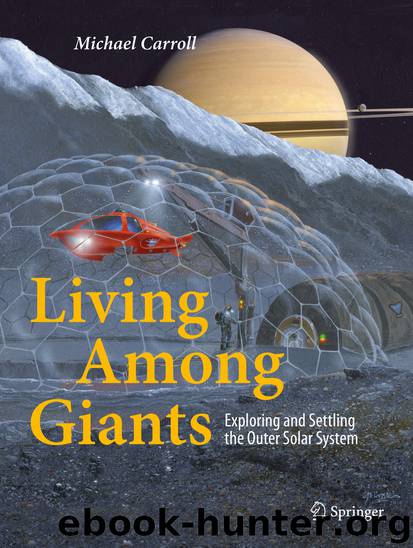Living Among Giants by Michael Carroll

Author:Michael Carroll
Language: eng
Format: epub
Publisher: Springer International Publishing, Cham
All of the theories of ridge formation seem exotic to researchers like John Spencer. “The idea that there was a ring that collapsed onto the surface – which seems crazy, too – may be more likely. I still think it’s crazy, but I don’t have any better ideas.”
Recently, observers detected a debris ring around the asteroid 10199 Chariklo, a body orbiting between Saturn and Uranus. This Centaur-class asteroid probably originated as a Kuiper Belt Object. It is estimated to be 250–300 km across, or one-third the size of Iapetus. William McKinnon comments, “What I think hasn't really been emphasized in the ‘ring around a Kuiper Belt Object’ discovery is that this is the first evidence for a ring around any solid body in the Solar System. In that sense it is a proof of concept that satellites could have satellites, or rings, at least for a while.”7
Clearly, the jury is still out on the origin of the great ridge, but if the debris theory is correct, we may see a similar formation on another moon that has a similar gravitational arrangement with its other siblings. That moon is Uranus’ Oberon. It will be some time before we have high resolution data on this moon (see Chap. 3), so planetary researchers will have to bide their time, something they have become good at.
Tilmann Denk of the Free University of Berlin is a member of the Cassini imaging team. He helps to select targets for the spacecraft’s imaging system among the icy moons of Saturn. Here is what he says concerning about being on Iapetus: Iapetus’ surface gravity is about 2 to 3 % of Earth's. I expect it would resemble the situation on the Moon with respect to keeping order with untethered objects like glasses or plates or laptops, but walking should be done with extreme care. This is certainly different than walking on Callisto. When doing a moderate jump on Earth (just vertical from standing, not a running jump), your center of mass might reach a height difference of ~0.2 m before falling down, and the fun is over after less than half a second. On Callisto, the same jump would reach about 3 m (quite more fun), with a return after 4 to 5 seconds. On Iapetus, it's ~20 m, with a return after about half a minute (no fun anymore?). A non-vertical jump on Iapetus might transport you ~40 m away from your starting position. A vertical jump with equipment about equal in weight to what an astronaut carries would still allow you an easy jump of ~5 to 10 m altitude or ~10 to 15 m wide. In other words, an “extravehicular activity” outside a base should not be done without securing devices or jet pack.
Up on top of the ridge, the difference would be tremendous. Standing on the flat ground on Iapetus allows for a horizon view around 1.5 km away. Standing on a 15-km tall mountain would increase this to ~150 km or ~11 degrees in longitude and latitude in viewing direction if there's no obstacle like another mountain.
Download
This site does not store any files on its server. We only index and link to content provided by other sites. Please contact the content providers to delete copyright contents if any and email us, we'll remove relevant links or contents immediately.
Tools of Titans by Timothy Ferriss(7816)
Turbulence by E. J. Noyes(7702)
Astrophysics for People in a Hurry by Neil DeGrasse Tyson(5002)
Secrets of Antigravity Propulsion: Tesla, UFOs, and Classified Aerospace Technology by Ph.D. Paul A. Laviolette(4996)
Design of Trajectory Optimization Approach for Space Maneuver Vehicle Skip Entry Problems by Runqi Chai & Al Savvaris & Antonios Tsourdos & Senchun Chai(4843)
Room 212 by Kate Stewart(4739)
Pale Blue Dot by Carl Sagan(4619)
The David Icke Guide to the Global Conspiracy (and how to end it) by David Icke(4383)
A Journey Through Divination and Astronomy by Publishing Pottermore(4250)
Apollo 8 by Jeffrey Kluger(3513)
Goodbye Paradise(3446)
Losing the Nobel Prize by Brian Keating(3425)
COSMOS by Carl Sagan(3350)
The Five People You Meet in Heaven by Mitch Albom(3335)
How to Read Water: Clues and Patterns from Puddles to the Sea (Natural Navigation) by Tristan Gooley(3240)
Brief Answers to the Big Questions by Stephen Hawking(3240)
How to Read Nature by Tristan Gooley(3080)
The Order of Time by Carlo Rovelli(3073)
A Brief History of Time by Stephen Hawking(2819)
